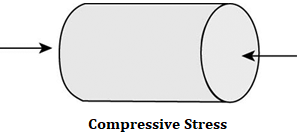Compressive Stress
When an external force is applied to a body then at each cross section of the body an internal restoring force is setup which tends to restore the body to its original state. The restoring setup inside the body per unit area is known as stress. The normal stresses can be either tensile or compressive whether the stresses act out of the area or into the area.
There are three ways to deform a solid with the help of external force. Compressive stress is the one among three ways.
What is Compressive Stress?
Compressive stress is defined as the stress experienced by a material which leads to a smaller volume. In order to increase the compressive stress, compressive strength must be reached. It can also define as the measure of force that one needs to break a material.
Examples in which compressive stresses are developed are connecting rods, link of structure and column. The figure below shows the compressive stress developed under the application of the external load.

Formula of Compressive Stress:
The compressive stress that develops when an external compressive force is applied on an object is given by:
Stress (σ) = Force (F)/ Area (A)
Unit of compressive stress is N/ m². Higher the compressive force, higher the compressive stress. Compressive stress results in the shortening of the solid and it is due to the application of external compressive force. Compressive strength is the measure of force that one needs to break a material.
